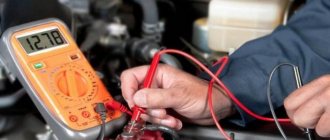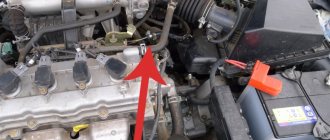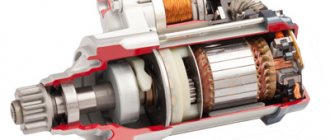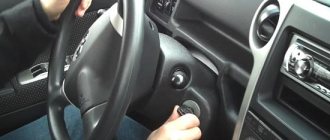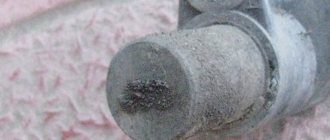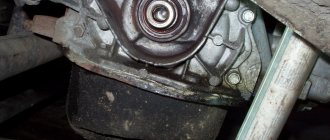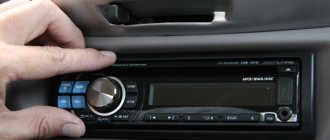The appearance of extraneous sounds after starting a cold engine, as well as during further operation of a warm engine, requires immediate clarification of the reasons. In the engine compartment you may hear engine knocking, whistling of belts and bearings of attachments, crackling or crunching noises, as well as other noises. Such sounds are superimposed on the overall smooth noise of the power unit, differing in strength, frequency and intensity.
We also recommend reading the article about what can knock in the engine. From this article you will learn how to determine the malfunction of various internal combustion engine components by the nature of the knock.
Whistling noise in a V-belt drive is usually caused by friction. A whistling sound appears due to the loss of one or two contacting surfaces of their properties. We add that belts, bearings and pulleys are influenced by the humidity of the outside air, temperature, degree of wear and damage, the amount of lubricant in the bearings, the quality of the belt drive adjustment and other factors. Next we will talk about what can most often make a whistle under the hood when starting the engine.
Finding the source of the whistle
Check what is the most likely cause of the sound. Determine if the whistle is heard only during startup. It may also manifest itself in other situations. Also check if the sound only occurs when you start the engine at low temperatures. It can also be heard when starting in warm conditions. Make sure the car is in neutral or park and have someone start the car while you stand outside with the hood open. Listen carefully and try to determine the place from which the creaking is heard.
Rollers and bearings
Another element of a car engine that can make unpleasant noises is all kinds of bearings and rollers, which are present in many engine components. Often, when malfunctioning, they produce sounds slightly different from the usual whistle - a low-pitched howl. This sound appears when the engine is running at idle speed, but intensifies with increasing speed and immediately disappears or becomes much quieter. If you determine that the engine whistles precisely because of these elements, then you can “cure” it by replacing the failed parts.
[custom_ads_shortcode3]
V-ribbed belts or car alternator
If the sound is really “creaking”, then most likely it comes from the alternator area or from the drive belts. This is the most common cause of squeaking noises when starting the engine. A harsh sound from a car alternator can be caused by one of three reasons: the alternator belts or serpentine belts are worn out, the pulley is not working properly, or the internal bearings are worn out.
An example of a complex belt arrangement for several units. The belt can be put in order on your own. Check the belt for cracks and abrasions, and see if it is loose. If the belt is damaged, replace it. You can also replace the pulley if you have a spare and feel up to the task.
Intake system malfunctions
If you hear a whistle when the engine is running, and you are already convinced that the reason does not lie in something else, then most likely there is some kind of malfunction in the engine intake system. This could be either the throttle valve, which periodically jams and creates specific air turbulence, or the PCV intake valve, which is responsible for recirculating crankcase gases.
In the first case, whistling when the engine is running is eliminated by thoroughly flushing the throttle valve. But in order to thoroughly clean it from dirt, it is necessary to completely remove this unit, which should not be forgotten.
In the second case, the problem is a clogged PCV valve of the intake system. Because of this, hot air from the crankcase cannot circulate normally, which leads to oil being squeezed out through the seals due to excessively high pressure and the appearance of that same whistle when the engine is running. The real problem can be “cured” by simply cleaning this valve.
To do this, you need to remove the valve, which is located either on the valve cover or next to the air filter on the crankcase ventilation tube. If the valve is metal, then any cleaning products that will not scratch the surface will work perfectly. If it is plastic, then overly aggressive aerosols and liquids should be avoided.
[custom_ads_shortcode1]
Whistle when starting the engine, unrelated to the generator
Any squeaking or whistling sounds are usually attributed to belts somewhere in the engine. So if you notice these types of noises, it's a good idea to check all the other belts in the car. While in modern cars, the alternator and most components are driven by serpentine belts, older cars often use V-belts. In addition, the timing belt may also produce a squeaking sound. A squeaking or whistling sound is always a sign that the belt is worn or improperly tightened.
Adjust the tension of all belts or replace them if any belts are cracked or simply worn out. When this does not help get rid of the squeak, you should contact a mechanic.
It's not necessarily a belt: what's whistling under the hood and what to do about it?
It seems that everything is said about the whistle: some belt is slipping. Just? Almost, because the belt is not always to blame, it doesn’t always slip for no reason, and if you try to do better, you can only do harm.
From simple to complex
Let's start with the belts. Whatever one may say, most often they are the ones who really whistle. Of course, the timing belt cannot whistle - it is toothed, but all other accessory belts (drive or service belts - as you like) can whistle very loudly.
The reason for the whistling may vary. Firstly
, a weak belt tension may be to blame. It's too obvious and simple.
Secondly
, the belt itself is getting old. Over time, it “dumbs” - loses elasticity. Such a belt can no longer fit well enough to the pulley and begins to slip, even if everything is in order with the tension. And if, on top of everything else, it is also “eaten” by tens of thousands of kilometers, then a whistle will definitely appear.
Third
, the belt may simply be dirty. Here you need to figure out why it is dirty. If the car does not have normal protection from below, then everything is clear: water, sand, dust - all this settles on the belt. And if the water dries out quickly, then the same sand cannot dry out, but it’s easy to gnaw out the rivulets of the belt.
It also happens that something from the car leaks onto the belt: oil, antifreeze or brake fluid (the latter, of course, is unlikely, but still). And while antifreeze or brake fluid most likely won’t do much harm, motor oil is a rather aggressive thing that corrodes the belt material. If the belt is covered in oil, it must be replaced. And, of course, only after the cause of its spraying is found and eliminated.
Since not only the belt can whistle, you will also have to make sure that it is the culprit of the squeal. The easiest way is to spray water on it. If the belt has simply become stiff from age, then a little help may help. Or maybe not, because if he is weakened, then the whistling will become even stronger. But at least you can understand from the change in sound that something is wrong with the belt. This is especially convenient if there is more than one drive belt: water will help you find out which belt is whistling. Well, if it doesn’t work, then nothing terrible will happen: the water will simply dry up. With the currently fashionable belt sprays, the situation is more complicated.
Theoretically, these sprays are designed not so much to diagnose the problem as to solve it. The spray usually contains a fun ingredient like pine tree resin. Resin is nothing more than ordinary rosin, which costs 20 times less than a spray. True, it is difficult to apply it to a belt, but the principle of action is exactly the same: increasing friction. The spray also contains alcohol, which can soften the belt a little. It seems that the recipe is perfect: the hardened belt gains elasticity, and the resin increases friction. But life is not all so rosy.
Adjusting and replacing the belt
If you feel like the belt is loose, you can try adjusting the belt tension. First, find the belt tensioner. This is a small roller that is driven by a spring, and with it you can adjust the tension. To adjust, simply loosen the nut, then you can adjust the belt as you wish. If you are going to replace the belt, you can also install a new pulley to extend its service life.
A belt with a poor-quality tension mechanism wears out quickly. A worn tension mechanism can also squeak. Install the new tensioner and pull the belt through the rollers in the same direction as before. This is more difficult to do with a serpentine belt, so check the diagram showing the belt direction under the hood. If it is not there, check the user manual.
A whistle when starting the engine is an important signal of belt wear and a generator malfunction; if you are not sure that you can handle it yourself, contact a mechanic.
Why is there a whistling sound when cold?
There are four main reasons why a whistle occurs during a cold start. Let's look at them in order from the most common to the "exotic".
Alternator belt problem
The most common reason that a whistle is heard when starting the engine when cold is that the alternator belt in the car engine is slipping. In turn, this may be caused by one of the following reasons:
- Weak belt tension . Typically, the alternator belt does not have teeth, like a timing belt, so its synchronous operation with the pulley is ensured only by sufficient tension. When the corresponding force is weakened, a situation arises when the generator pulley rotates at a certain angular speed, but the belt on it slips and “does not keep up” with it. This creates friction between the inner surface of the belt and the outer surface of the pulley, which often results in whistling sounds. Please note that if the tension is weak, a whistle can occur not only when starting the engine, but also with a sharp increase in engine speed, that is, when accelerating. If so, check the belt tension.
- Worn belt . Like any other car part, the alternator belt gradually wears out over time, in particular, its rubber becomes tanned, and accordingly, the belt itself loses its elasticity. This naturally leads to the fact that, even with proper tension, it cannot “catch” onto the pulley to transmit torque. This is especially true at low temperatures, when already dried rubber becomes frozen. Accordingly, when starting the engine when cold, a short whistle is heard, which disappears as the engine and the alternator belt itself warm up.
- The appearance of dirt in the streams of the generator pulley . Often, a whistling noise under the hood when cold occurs not for a reason directly related to the belt, but because dirt accumulates in the pulley streams over time. This leads to the belt slipping along its working surface, and is accompanied by whistling sounds.
How to eliminate a whistling alternator belt
Why does the alternator belt whistle and how to deal with it. 5 main reasons for a whistling belt (alternator belt, power steering belt, water pump, air conditioning compressor). Causes of belt whistling and tips for eliminating it. More details
Similar reasoning is valid for other belts used in the car. In particular, the air conditioning belt and the power steering belt. If left idle for a long time at a cold temperature, they can become stiff and make whistling sounds until they warm up as a result of their work. Similarly, they can whistle due to weak tension and/or due to severe wear.
In rare cases, frost can cause the grease in the generator shaft bearing to thicken significantly. In this case, immediately after starting, the belt may slip, since the engine needs to apply more force to unwind the generator shaft. Usually, after the lubricant acquires a more liquid consistency, the belt slippage, and therefore the whistling sounds, disappear.
Also, in rare cases, the belt may whistle and slip due to the fact that moisture condenses on its inner surface (adjacent to the drive pulleys). For example, when the car is parked for a long time in conditions of very high humidity (at a car wash, in a hot sea climate). In this case, after starting the engine, the moisture will naturally evaporate and the whistle will disappear.
Like moisture, various process fluids can get onto the belt. For example, motor oil, antifreeze, brake fluid. In this case, the duration of the whistle will depend on how much liquid gets on the belt and how quickly it is removed from its surface. In this case, in addition to assessing the condition of the belt and its tension, it is necessary to diagnose why this or that process fluid gets on the belt. And carry out the appropriate repair measures. They will depend on the reason.
Worn tension roller
In cars equipped with a tension roller, this can be the source of the whistling “when cold”. In particular, the roller bearing, which gradually fails. It may also whistle or crackle at certain engine speeds. Diagnostics of the roller must begin with checking the tension. Often, the roller begins to whistle when the drive belt or timing belt is under- or, conversely, over-tensioned. Please note that over-tightening a belt is harmful to the bearings of the individual rollers and pulleys that said belt connects.
You also need to assess his general condition. To do this, you need to remove the roller from its seat. Next, you need to inspect its wear and ease of rotation of the bearing. Be sure to check the roller (bearing) for play, and in different planes. Along with the roller diagnostics, you also need to check the condition of the belts.
Water pump failure
The pump, or another name for the water pump, can also make a whistling noise when starting the engine when cold. On some older cars, the pump is driven by an additional belt from the crankshaft pulley. In modern cars, it is rotated by the timing belt. Therefore, often on older cars, the pump drive belt can also stretch and slip over time. An additional source of unpleasant sounds can be a worn pump pulley. The belt will slip over it and whistle.
Often, when the belt heats up, the whistling disappears, because if the belt is not stretched too much, it stops slipping and, accordingly, the whistling sounds will go away as the power unit warms up.
Similarly, as with a generator, the water pump’s bearing grease may thicken, or even be completely washed out of its working cavity by antifreeze. In this case, there will be a slight whistle when starting the engine when cold. However, if there is no lubrication at all, then often whistling sounds will be heard not only when it is cold, but also while the car is moving on the road.
Please note that if the whistle appears constantly, and not just “in cold weather,” then there is a high probability of failure of the bearings of the generator, pump, and air conditioner elements. Therefore, in this case, it is also necessary to check the bearings.
In addition to these obvious and explainable reasons for whistling under the hood when cold, there may also be some that are completely unrelated to the operation of the belt and rotating mechanisms. So, for example, when warming up the engine on VAZ cars (in particular, Lada Granta), there may be such a rare case as resonance of the crankshaft position sensor. So, the sensor (abbreviated DPKV) produces a high-frequency squeaking sound between its internal parts, as well as the engine housing. This is due to the design feature of the sensor.
Which ear?
“Tell me, dear child, in which ear I have a buzzing...” The monumental phrase of Faina Ranevskaya is more relevant than anywhere else in this case. Because whistling can, indeed, be heard in “both ears.” It may not be the alternator drive belt at all, there may be many reasons, but first you should understand the nature of the whistle under the hood, only after that you can draw some conclusions.
The cause of any whistle in V-belt drives of cars can only be friction
It doesn’t matter what interacts with what, if a whistle occurs, it means that one of the surfaces, or maybe both at once, has lost its original properties and physical characteristics. The characteristics of belts, bearings, and pulleys are influenced by a lot of external factors:
- air humidity;
- working temperature;
- natural wear and tear;
- mechanical damage;
- presence of lubricant in bearings;
- technical condition and adjustment of V-belt or toothed belt drive.
The photo shows a generator belt, which can be adversely affected by lubrication in bearings, air humidity, and operating temperature
These are just some of the things that can cause whistles and squeaks under the hood, but if you take into account the conditions in which annoying sounds appear, the problem is much easier to fix. We will start from the simplest.
Whistle when pressing the gas pedal at a speed of 70 km/h
Hello! Has anyone encountered this problem: when you press the gas pedal while driving, at a speed of more than 65-70 km/h, you hear a whistle, not very loud, but noticeable. If you release the gas, the whistle disappears. The car is almost 2 years old, automatic transmission, mileage is about 25,000 km. In my opinion, this whistle was there from the very beginning, at least for a long time. Not progressing. In the spring I contacted the dealer and had the valve cover replaced under warranty. The whistle remained, but there was no time to study in the summer. Now I’ve contacted them and they suspected a defect in the support bearings of the automatic transmission shafts. At the same time, the master first took me for a ride and said that all the machines whistle like that. They suggest leaving the car for min. for 2 week. Could it be that the defect has not become stronger in 2 years? The warranty is running out, I don’t know whether to agree to have the box rebuilt?
Solna
Don’t interfere with the car’s movement, they will overcharge you so much that you will become a regular guest of this service and will only arrive with a tow truck. Agree only to a replacement due to antifreeze leakage into the box..
In general, Zafira B..od, not ASTRAvod.. Zafira B 1.9 CDTI (Z19DTH - 150+EDS) Black OPC Line Panorama.
Repair of a jammed ASTRA H rear windshield wiper.
The service is provided at your location.
Thank you. Yes, I am also confused by the prospect of repairing the box, provided that it is not clear whether there is a problem or whether there is one at all. But it would be calmer to know that someone has encountered such a sound and that this is a variant of the norm, i.e., with a longer service life no additional problems have arisen. Owners of cars with automatic transmission! Has anyone encountered something similar? Write please!
On the 2010 N-ke there is also a whistle. It's something whistling from the box. Precisely on automatic transmission. Like from a turbine.
And I completely agree with the previous speaker.
Thank you! So it's most likely normal. It’s just not my first car with an automatic transmission (it wasn’t an Opel) and I’ve never had anything like that.
I have a manual car, and there is also a whistle when accelerating, the rpm is about 3000. When you release the gas, the whistle disappears. I called the dealer and they said I need to look at the throttle assembly.
Troubleshooting under operating conditions: 2266 Problem: Engine Z16XE1/LET/LER/XEP/XER/Z18XER - Whistling noise Model: Engines: Options: Astra-G 2003. 2005,Astra-H 2004. 2008,Zafira-B 2005. 2008 ,Meriva 2006. 2008,Corsa-D 2007. 2008,Vectra-C 2006. 2008,Signum 2006. 2008 Z16XEP,Z16XE1| Z16XER| Z16XEP| Z16LET| Z18XER,Z16XE1| Z16XER| Z16XEP| Z18XER,Z16XEP| Z16LET,Z16LEL| Z16LER,Z16XEP| Z18XER,Z18XER Complaint: Customer complains of a whistling noise in the engine, sometimes code P0105 (MAP sensor) and P0170 (air/fuel mixture) are logged in the ECU. Cause: Cracked air pressure membrane inside the cylinder head cover. Manufacturing: Starting with engine No. 20MV7706 (13-Oct-2008), improved parts were introduced into production.
Troubleshooting: In the event of a customer complaint, remove the oil level dipstick or remove the oil filler cap. If the whistling noise disappears, replace the cylinder head cover. When considering options with a MAP sensor, it is also possible to check Manifold Absolute Pressure (MAP) using Tech 2. At idle and no load, it should be approximately 32 to 38 kPa. Functional group: J - engine Fault group: 01 - breakage or crack, 14 - noise or vibration Fault code: P0105, P0170
Author: Sochi Auto Repair
During the operation of a car, situations inevitably arise that alarm the driver. One of these problems is the annoying whistle of a running engine. Why does the engine whistle? The problem is not the most serious, but it prevents the driver from concentrating on the road and distracts him from the process of driving.
Drivers often turn to specialists at service stations with the same complaint - a low, annoying whistle that occurs when the gas pedal is pressed, persists while driving, and then slowly stops after the gas pedal is released, and this cycle is repeated every time the pedal is pressed. . Usually only the driver of the car reacts to this whistle.
Why does the engine whistle?
If a car enthusiast understands at least a little about the material part of his car and feels it, he can fix this problem on his own.
The main signs of a whistling engine sound:
- the whistle starts when the gas pedal is pressed;
- the whistle is very quiet and can be heard in the absence of other sounds in the cabin;
- after releasing the gas pedal, the whistle subsides;
- Usually this sound remains unnoticeable for a long time and “appears” somehow completely suddenly;
- such a whistle is not heard outside the car, and passengers do not notice it at all, since they do not feel the connection between the occurrence of the sound and the pressing of the gas pedal;
- In timbre, this sound resembles a “human” whistle and differs significantly from “squealing”, “howling”, “creaking” and “grinding”.
Why does the engine whistle? First, you need to exclude possible sources of the problem with a similar sound. First of all, problems with the brake pads are eliminated, because their “squealing” occurs when you press the brake pedal (or gas pedal + brake pedal).
All problems with belts located under the hood next to the engine are also eliminated.
Belts are the main source of whistling sounds under the hood, but their tone and intensity are completely different. The belts begin to whistle while the engine is warming up. Their problem is slipping relative to the driving and driven rollers.
The moment you press the gas, the belt comes into unison with the rollers, normal operation begins and the whistling stops. It is simply impossible not to notice the whistle emitted by the belt - it is very loud and annoying. The issue of quiet and monotonous sound is also discussed here.
The third possible source of sound why the engine whistles is rollers and bearings. During operation, these parts wear out a lot and begin to “sound,” but they produce sounds of a different type - low, howling. The rollers and bearings begin to “howl” even at idle speed; after pressing the gas, the sound intensifies, but then subsides.
For an experienced technician, the difference between a “howl” and a “whistle” is obvious, especially if a professional is repairing the machine.
After analyzing all the symptoms and options, eventually a good auto mechanic will realize that the source of the problem is the engine intake system.
Eliminating the causes of a whistling engine sound
If a whistling sound is localized at the intake, it is necessary, firstly, to carry out maintenance on the throttle valve - it must be cleaned.
Constant use of the throttle valve leads to severe contamination of the moving parts and, as a result, to “jamming” in certain positions. Because of this, the air, passing under pressure through the damper, begins to whistle. Sometimes, to eliminate the sound, it is enough to simply rinse the damper thoroughly. However, we must remember that in order to properly clean the throttle assembly, it must be removed and completely disassembled.
This is a useful preventive procedure, but it does not always eliminate the whistling.
Therefore, it is necessary to focus on the next device in the intake system - the PCV valve. It is responsible for recirculating crankcase gases. When the engine is running, the air pressure in the crankcase increases due to the movement of the cylinder pistons and heating of the air. Hot air requires additional outlet, otherwise the high pressure will squeeze the oil through the oil seals and any seals. It is impossible to replace the valve with a regular ventilation hole - this may lead to incorrect formation of the air mixture at the inlet.
To understand why the engine whistles and where the whistle comes from, it is necessary to consider the valve design. The valve body has a piston pressed by a spring on the air outlet side. If the engine is turned off, the valve is closed. When the required crankcase gas pressure is reached on the valve, the spring moves, allowing gases to enter the intake system.
If the spring is contaminated with used oil, the valve stops closing completely. Air begins to flow into the resulting gap, producing a quiet whistle.
When you press the gas pedal, the throttle valve opens and air enters the rarefied atmosphere of the intake manifold. It is the vacuum that causes air to be drawn in and a whistle to appear.
When the PCV valve is completely stuck, oil leaks into the intake manifold. The presence of oil stains is a signal to clean the valve.
Simply cleaning the valve will help get rid of the whistling noise.
A simple method for cleaning the valve:
- remove the valve (located on the valve cover or on the crankcase ventilation tube next to the air filter);
- find out what material the valve is made of. If the valve is metal, then any cleaners (aerosols, liquids, pastes) can be used. The main thing is not to scratch the surface. Cleaning sequence: treat the surface, move the valve. Repeat until complete freedom of movement. To clean the plastic valve, do not use too aggressive liquids (the housing may be damaged);
- After cleaning, put the valve back in place.
As a result, after the measures taken, the whistling should stop. If auto mechanics have checked the brake pads, belts, bearings, rollers, and other mechanisms and confirmed their serviceability, then cleaning the valve will help rid the engine of annoying and irritating whistling.
We found out why the engine whistles, as long as our brains don’t whistle!
Surely every driver has noticed a characteristic whistle appearing in the engine compartment. Indeed, this is an unpleasant moment, both for the driver himself and for the people around him. The most important thing is to understand that the whistle, depending on the places where it appears, will differ significantly and, accordingly, by the nature of the whistle, an experienced driver or a mechanic at a service station can immediately determine the unit from which the unpleasant sounds originate.
Sharp growling sounds in the crankshaft area
The need for engine overhaul may be indicated by sharp growling sounds coming from the crankshaft area. As a rule, they occur when pressing the gas pedal. In cars with a manual transmission, there are often cases of sharp knocking when pressing the clutch pedal. This indicates depreciation of the clutch basket, crankshaft thrust rings, or failure of the engine thrust mounts.
The knocking noise occurs when there is no obvious failure of parts
The reasons for this type of knocking are associated with high loads, insufficient oil viscosity, as well as misalignment or jamming of one of the parts. If the engine parts have not yet developed any obvious damage, the unpleasant sound disappears after removing the critical factors. Often, to eliminate knocking, it is enough to check the oil level - an insufficient amount of lubricant quite often provokes deformation of parts that cause knocking.
Normal resonance
It turns out that the whistling sound can also be created solely as a result of vibration and resonance of certain components (at high speed). For example, one of the reasons for the whistling sound in BMW was the noise produced by the planetary gears. Moreover, such noise is typical for most cars.
The variety of car models produced is simply amazing, and each of them has its own characteristic features. If you are unable to detect any of the described faults, read car forums dedicated specifically to your model, or seek help from a qualified auto mechanic who knows his business well. There are even mechanics who can diagnose the problem just by listening to the sound of the car!
Author: Sochi Auto Repair
During the operation of a car, situations inevitably arise that alarm the driver. One of these problems is the annoying whistle of a running engine. Why does the engine whistle? The problem is not the most serious, but it prevents the driver from concentrating on the road and distracts him from the process of driving.
Drivers often turn to specialists at service stations with the same complaint - a low, annoying whistle that occurs when the gas pedal is pressed, persists while driving, and then slowly stops after the gas pedal is released, and this cycle is repeated every time the pedal is pressed. . Usually only the driver of the car reacts to this whistle.
Why does the engine whistle?
If a car enthusiast understands at least a little about the material part of his car and feels it, he can fix this problem on his own.
The main signs of a whistling engine sound:
- the whistle starts when the gas pedal is pressed;
- the whistle is very quiet and can be heard in the absence of other sounds in the cabin;
- after releasing the gas pedal, the whistle subsides;
- Usually this sound remains unnoticeable for a long time and “appears” somehow completely suddenly;
- such a whistle is not heard outside the car, and passengers do not notice it at all, since they do not feel the connection between the occurrence of the sound and the pressing of the gas pedal;
- In timbre, this sound resembles a “human” whistle and differs significantly from “squealing”, “howling”, “creaking” and “grinding”.
Why does the engine whistle? First, you need to exclude possible sources of the problem with a similar sound. First of all, problems with the brake pads are eliminated, because their “squealing” occurs when you press the brake pedal (or gas pedal + brake pedal).
All problems with belts located under the hood next to the engine are also eliminated.
Belts are the main source of whistling sounds under the hood, but their tone and intensity are completely different. The belts begin to whistle while the engine is warming up. Their problem is slipping relative to the driving and driven rollers.
The moment you press the gas, the belt comes into unison with the rollers, normal operation begins and the whistling stops. It is simply impossible not to notice the whistle emitted by the belt - it is very loud and annoying. The issue of quiet and monotonous sound is also discussed here.
The third possible source of sound why the engine whistles is rollers and bearings. During operation, these parts wear out a lot and begin to “sound,” but they produce sounds of a different type - low, howling. The rollers and bearings begin to “howl” even at idle speed; after pressing the gas, the sound intensifies, but then subsides.
For an experienced technician, the difference between a “howl” and a “whistle” is obvious, especially if a professional is repairing the machine.
After analyzing all the symptoms and options, eventually a good auto mechanic will realize that the source of the problem is the engine intake system.
Eliminating the causes of a whistling engine sound
If a whistling sound is localized at the intake, it is necessary, firstly, to carry out maintenance on the throttle valve - it must be cleaned.
Constant use of the throttle valve leads to severe contamination of the moving parts and, as a result, to “jamming” in certain positions. Because of this, the air, passing under pressure through the damper, begins to whistle. Sometimes, to eliminate the sound, it is enough to simply rinse the damper thoroughly. However, we must remember that in order to properly clean the throttle assembly, it must be removed and completely disassembled.
This is a useful preventive procedure, but it does not always eliminate the whistling.
Therefore, it is necessary to focus on the next device in the intake system - the PCV valve. It is responsible for recirculating crankcase gases. When the engine is running, the air pressure in the crankcase increases due to the movement of the cylinder pistons and heating of the air. Hot air requires additional outlet, otherwise the high pressure will squeeze the oil through the oil seals and any seals. It is impossible to replace the valve with a regular ventilation hole - this may lead to incorrect formation of the air mixture at the inlet.
To understand why the engine whistles and where the whistle comes from, it is necessary to consider the valve design. The valve body has a piston pressed by a spring on the air outlet side. If the engine is turned off, the valve is closed. When the required crankcase gas pressure is reached on the valve, the spring moves, allowing gases to enter the intake system.
If the spring is contaminated with used oil, the valve stops closing completely. Air begins to flow into the resulting gap, producing a quiet whistle.
When you press the gas pedal, the throttle valve opens and air enters the rarefied atmosphere of the intake manifold. It is the vacuum that causes air to be drawn in and a whistle to appear.
When the PCV valve is completely stuck, oil leaks into the intake manifold. The presence of oil stains is a signal to clean the valve.
Simply cleaning the valve will help get rid of the whistling noise.
A simple method for cleaning the valve:
- remove the valve (located on the valve cover or on the crankcase ventilation tube next to the air filter);
- find out what material the valve is made of. If the valve is metal, then any cleaners (aerosols, liquids, pastes) can be used. The main thing is not to scratch the surface. Cleaning sequence: treat the surface, move the valve. Repeat until complete freedom of movement. To clean the plastic valve, do not use too aggressive liquids (the housing may be damaged);
- After cleaning, put the valve back in place.
As a result, after the measures taken, the whistling should stop. If auto mechanics have checked the brake pads, belts, bearings, rollers, and other mechanisms and confirmed their serviceability, then cleaning the valve will help rid the engine of annoying and irritating whistling.
We found out why the engine whistles, as long as our brains don’t whistle!
Did you like the article? Share with your friends on social networks!
"Quading" tapping
Usually, “fading” knocking sounds coming from under the hood are not so critical. They can appear and disappear over tens of thousands of kilometers without any particular reason or change.
Because when the source of noise is the unit itself, this often indicates a malfunction, defects or natural depreciation of moving parts. For example, about problems in the gas distribution mechanism or in the connecting rod and piston groups. Usually these are very sharp knocks, the intensity of which is directly related to the increase in crankshaft speed. That is, the tapping increases in frequency while pressing the accelerator pedal.
Transmission problems
One of the first causes of a whistling sound is friction between transmission components. This may occur due to gear wear or low transmission fluid levels. To determine if the problem is with the transmission, do the following: Accelerate the car to the speed at which the whistle is loudest, put the transmission in neutral, and turn off the engine.
If the whistle does not disappear, then the problem lies in the transmission, and if it disappears, look for the cause in the engine or clutch system. A thorough transmission check will help solve this mystery.
Whistle during acceleration may be due to problems with the transmission
[custom_ads_shortcode2]
Noise when the engine is cold
If literally immediately after starting the engine began to function with a slight tapping sound, but when it warmed up well the extraneous noise disappeared, there could be a lot of reasons for this. But the main thing is that this problem is not so critical and you can safely drive the car further. However, before each trip you should remember to warm up the engine thoroughly.
This occurs due to the natural depreciation of the parts of the unit, which create this noise. However, when heated, the tapping parts expand and regain their normal clearances.
Turbine malfunctions
Many modern cars are equipped with turbochargers, which significantly increase their power and driving performance. But this is another component in the engine that can signal its malfunction with a characteristic and loud whistle. The reason for this may be an air leak at the junction of the engine and the turbocharger.
Usually such sounds indicate the imminent “death” of this important part. This malfunction most often occurs on machines that consume diesel fuel. Therefore, the owners of such cars know that the whistling of a diesel engine turbine does not lead to anything good.
[custom_ads_shortcode2]
What do extraneous noises mean?
The sounds of a normally functioning machine should not cause discomfort. Any unusual background signals that something in the vehicle is not working as it should. To find out the cause of extraneous sounds, you first need to determine whether they are external or internal sounds.
If you have already established the approximate source, it will be much easier to find out the reason. Simple observations of what the noise is synchronized with and under what conditions it occurs will also help in this matter.
My Sonata Club Hyundai Sonata
Whistle when turning the steering wheel to the left
The heart of the Sonata is the engine, engine compartment sensors, engine control system (ECU)
Alexey010Newbie Messages: 7 Registered: Jan 27, 2012, 4:41 pm Reputation: 0 Auto: Real name: Alexey From: Tula
Message by Alexey010 » January 27, 2012, 16:55 » Message # 186853
Sonata 2.0 automatic transmission 2005, when the engine starts, a whistle appears and continues for about 5-6 seconds, then it hits. The belts and rollers have been changed.
Message by Shind » Jan 27, 2012, 04:58 pm » Message # 186856
Tighten your belts.
There was a Sonya AT-4.2006-2011. Remained in the club in good hands (for the third time). Mitsubishi XL 3.0/ 220 thousand hamsters + several thousand after miracles/Silver 2011-2017 (sold) Volkswagen Touareg 3.6 FSI 249 hp blacker than the night, pneuma and everything to the maximum.
ShindAksakalMessages: 5487Registered: March 28, 2010, 21:51Reputation: 43Car:Real name: AlexeyFrom: Moscow
Post by Shind » Jan 27, 2012, 5:13 pm » Message # 186865
Are you sure? That’s what many said, argued with all the comrades and as a result pulled it up and everything was lost.
There was a Sonya AT-4.2006-2011. Remained in the club in good hands (for the third time). Mitsubishi XL 3.0/ 220 thousand hamsters + several thousand after miracles/Silver 2011-2017 (sold) Volkswagen Touareg 3.6 FSI 249 hp blacker than the night, pneuma and everything to the maximum.
TYRISTYI live hereMessages: 1865Registered: 04 Jan 2012, 15:25Reputation: 1Car:Real name: PavelFrom: Ukhta, Komi region
Post by TYRIST » Jan 27, 2012, 05:19 pm » Post # 186866
2.0, leather, Sirius, mechanics, climate, R-16 winter, R-17 summer.
Message by Bogind » January 27, 2012, 20:48 » Message # 186951
depending on where the whistle is coming from and the muffler may be the pump and the bearing may be losing and making a whistle lia-maks Joined Messages: 220 Registered: 09 Jan 2012, 22:26 Reputation: 0 Car: Real name: Ildar From: Kazan
Post by lia-maks » Jan 28, 2012, 05:21 pm » Post # 187315
I have the same problem with the same engine, everything is tight, the whistle does not disappear, I blame the power steering pump bearing!
I'm selling complete cast wheels!
Alexey010Newbie Messages: 7 Registered: Jan 27, 2012, 4:41 pm Reputation: 0 Auto: Real name: Alexey From: Tula
Message by Alexey010 » 18 Feb 2012, 09:46 » Message # 194982
The belts were tightened by the officials, the whistle disappeared, but after a week it starts again, but not the same as it was, a little quieter and rustier
clon76 Slowly getting in Messages: 85 Registered: 09 Oct 2010, 01:41 Reputation: 0 Car: Real name: Vladimir From: Elektrostal
Message by clon76 » 18 Feb 2012, 19:54 » Message # 195132
And the high pressure hose isn't leaking? Or as an option...
matvei55 Newbie Messages: 4 Registered: November 16, 2011, 21:00 Reputation: 0 Car: Real name: Nikolay From: matvei55
Message by matvei55 » 22 Feb 2012, 12:40 » Message # 196483
I have the same problem. It squeaks, and in the cold. How are the alternator and timing belts tightened? And what does it mean [And the high pressure hose does not snot?[
Last edited by matvei55 on Feb 27, 2012 10:59 pm, edited 1 time in total.
Message Vladimir 102 » 22 Feb 2012, 13:08 » Message # 196493
I have a whistle when I turn off the engine, the belts are all tightened, no one who asked anyone will understand what the reason is, and I’ve been driving like this for a year now
Sonata.Silver.2l.Beta. Manual transmission, 2MT. Kayaba all around, Killen rear springs -1.25 turns. Sold.
sergus151Newbie Messages: 2 Registered: March 15, 2012, 03:56 pm Reputation: 0 Car: Real name: Sergey From: Moscow
Message by sergus151 » March 31, 2012, 13:57 » Message # 208624
Hello) there is a problem like this, it whistles, I don’t know what to call it, to the left of the engine, one turns on the air conditioner and the other seems to be a generator. Tell me what is the name? Sonata 2004 2.0 liter
Go
Strong and loud tapping
If, during sharp pressure on the gas pedal or under high load, strong knocking sounds with a characteristic ringing echo appear, then most likely this is a consequence of explosive combustion of fuel in the cylinders (detonation).
The main root causes of detonation are considered to be the use of low-octane or low-quality fuel. In this case, the problem will be solved if you add an additive (which increases the knock resistance of gasoline) or add high-quality gasoline.
Also, the source of such a knock can be a very overheated engine or an incorrectly adjusted ignition timing. To eliminate these unpleasant effects, it is recommended to adjust the ignition system and cool the engine.
Loud chattering sounds
This type of noise is most often produced by foreign objects accidentally falling into attachments or moving parts of the motor. For example: pieces of insulation or plastic, leaves, branches, insects and others. Therefore, sometimes it is enough to look under the hood and pull out objects that accidentally appear there.
If the noise does not disappear, then these sounds may indicate more serious damage. As a rule, they indicate failure or delamination of the pump drive pulleys, power steering, and generator.
